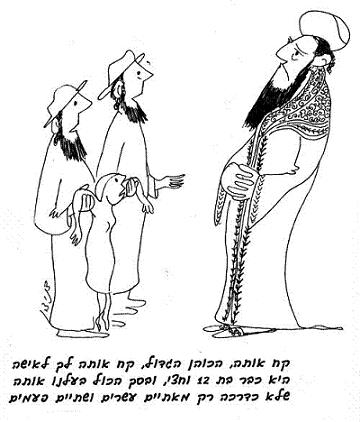
A High Priest is only allowed to marry a virgin, for it is written: “He who is the high priest… shall take a wife in her virginity” (Leviticus 21:13). The Scriptures specify further and state “A widow or a divorced woman or a defiled woman or a harlot — these he shall not marry; but he shall take a virgin of his own people as wife” (ibid.:14). The early sages (the Tanaaim) disagreed about the definition of the “virgin” who may marry a High Priest. According to one sage, once she reaches the age of puberty (above the age of twelve and a half) she is not considered fully a virgin, for a young lady’s hymen contracts. If she has had anal sex but her hymen remains intact, she may wed a High Priest. According to another sage, the exact opposite is true: a young woman, even though her hymen has contracted, may wed a High Priest, for part of her hymen remains, but if she has had anal sex she is forbidden to marry a High Priest. The scholars explained this disagreement by interpreting the words in her virginity. Since the Scriptures could have said this much more simply — “shall take a virgin” — yet chose to use the longer phrase in her virginity, it implies, the scholars argued, that the extra length is subject to exegesis. According to the first sage it means that a young woman, whose hymen has shrunk, is not permitted, and that a girl who has had anal sex is permitted. The other sage interpreted it to mean the opposite. The scholars went on to ask: a girl who has anal sex is considered a harlot, for the sage Rabbi Elazar stated that any single person who has had sexual relations for pleasure and not to affect a marriage, even if it is anal sex, is considered a harlot. A harlot is forbidden to marry a High Priest because it is written “A widow or a divorced woman or a defiled woman or a harlot — these he shall not marry.” If so, the scholars asked, one who has had anal sex is forbidden as a harlot and there is no need to forbid her to the High Priest based on the above exegesis which states that she is not considered a virgin. The same Rav Yossef replied that the exegesis above is of help in a case where she has had anal sex with an animal; on the one hand she is not considered a harlot, but on the other she is considered to have had sexual relations. One of the scholars, Abaye, noted that Rav Yossef’s statement contradicted itself. If a girl’s anal sex with an animal defines her as having had sexual relations, then she must be considered a harlot, and the two definitions cannot be separated. The sage continued and said that one cannot draw analogies from the case of a girl whose hymen was torn without sex (for example, because a piece of wood entered her sexual organ and tore her hymen and who, according to Rabbi Eliezer, is forbidden to marry a High Priest) to a girl whose anus was penetrated by a piece of wood, for there is no girl who has not wiped her anus with a stone and had that stone penetrate the edge of her anus; if such an analogy were drawn, the High Priest would be forbidden to marry anyone. So the question above remains: In what case is a girl who has had anal sex considered to have had sexual relations yet not be a harlot? Rav Zira answered that this is the case of a girl who married and had anal sex only, and then the marriage broke up. She is not considered a harlot because the sex was part of a marriage, but she is considered one who has had sexual relations and not a virgin.
According to another sage, Samuel, a girl who has had sexual relations with an animal is not considered a harlot and may marry a priest or even a High Priest. Even if her hymen was torn during this sex act she is considered as one into whom a piece of wood penetrated and tore her hymen, and some of the sages would permit her to marry a High Priest. There was an incident in the village of Haitalu in which a girl was sweeping her home. A dog came along behind her and sodomized her. They asked Rabbi Judah the Nasi and he permitted her to marry a priest because she was not to be considered a harlot.
(Babylonian Talmud, Tractate Yevamot 59a-b)
